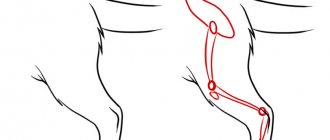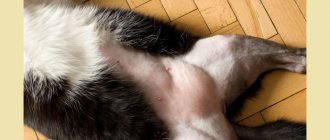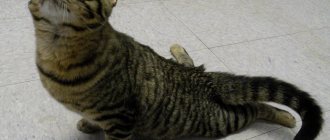Weakness in a cat's back legs is a clear sign that something is wrong. There are many reasons why this weakness can occur in the hind legs of animals and is often accompanied by other symptoms.
If you've come this far in your search for information, it's because you're concerned about your pet's health.
If so, we invite you to read the information we have compiled for you about hind leg failure in cats. In any case, always remember that a specialist’s opinion is necessary in this case. If you are concerned about your cat's health, we recommend that you take her to a veterinarian.
Causes of hind leg failure
A cat with pain or numbness in its limbs is a lethargic, weak animal with no appetite that spends the entire day lying down. The impairment can range from simple pain that limits freedom of movement to complete paralysis, tremors and seizures.
Since this symptom can be multifactorial, we decided to list for you the main reasons why cats' hind legs fail.
© shutterstock
Although being run over, getting into a fight, or falling can cause immobility, there are medical conditions that are more difficult to diagnose and have a less optimistic prognosis. These diseases include the following:
- Constipation:
Constipation, which is more common in cats with kidney disease, affects not only the digestive system, but also the lower back. This is why the hind legs lose strength and mobility.
If this situation persists for several days and is accompanied by vomiting and loss of appetite, you should make an appointment with your veterinarian as soon as possible to have your cat examined. Keep in mind that if the problem is chronic constipation, it can cause permanent damage to the liver, intestines and kidneys. In these cases, it is an issue that should not be taken lightly.
- Hip dysplasia:
This is one of the main reasons why dogs drag their paws. However, it is not such a common condition in cats.
In felines, hip dysplasia tends to run in families and is related to race.
It affects the hip bones from a very early age due to the fact that a defect occurs in the joint of the hip joint, which increases over the years due to wear and tear of the bones and friction.
Due to the fact that the hip and pelvic bones do not develop properly, cats experience constant pain, limited movement and eventually lead to osteoarthritis.
You should know that once your veterinarian diagnoses you with this condition, the problem will not go away because hip dysplasia is a degenerative and irreversible process that will deteriorate your cat's health over time.
This pathology is more common in large cats, such as the Norwegian Forest Cat or Maine Coon, with females being most affected.
- Thrombosis:
Thrombosis is a blood clot stuck somewhere in the body. In cats, the hips and paws are affected because blood does not flow normally to these areas and therefore their mobility is reduced.
In cats, the disease is known as stool thrombus, feline aortic thromboembolism. This condition is not as common in dogs as it is in cats.
Thrombus in the stool disease is characterized by damage to both one and both hind limbs. The paws become cold and the nerves and muscles become stiff and inflamed due to lack of oxygenation. Unfortunately, this is a life-threatening anomaly.
Renal failure is the main, but not the only cause of thrombosis. If you have questions, consult your veterinarian.
- Hypertrophic cardiomyopathy:
This is coronary heart disease, characterized by thickening of the walls of the heart.
This condition causes blood to not reach certain parts of the body, such as the hind legs and tail, because they are further away from the heart.
Hypertrophic cardiomyopathy can eventually lead to paralysis of the limbs, either completely or partially, due to lack of blood supply.
© shutterstock
- Spinal injuries:
Damage to the spinal cord can paralyze any animal. Cats are very flexible, in fact, they do not have collarbones, they fit into any hole, no matter how small it is. Consequently, injuries are very common among cats.
A veterinarian diagnoses the disease using an X-ray or MRI. Depending on your specific situation, your doctor can decide whether to proceed with surgery, medications, or rehabilitation.
- Feline panleukopenia:
This is a very dangerous viral disease that is spread through urine, feces and fleas and spreads between unvaccinated cats.
This disease leaves the animal with effects that make it difficult for them to move, they cannot stand up completely, they lift their legs to be able to move, and they easily lose their balance.
Although in this case the hind legs do not completely fail, it does affect mobility.
- Diabetes:
Increased blood glucose levels and decreased potassium levels cause certain neurological disorders that most often affect the extremities.
Other possible diseases:
Other reasons why a cat’s back legs fail:
- Cancer
- Leukemia
- Feline immunodeficiency virus
- Osteoporosis
- Herniated discs
- Spinal cord injuries
- Osteoarthritis
Lameness with stomach pain
A common cause of lameness is stomach pain. Prolonged constipation, inflammation of the gastric mucosa or intestinal obstruction are all dangerous pathologies that require an urgent visit to the veterinarian.
With constipation and intestinal obstruction, hard feces can cause short-term paresis and paralysis. If a cat behaves lethargically, refuses food and water, drags its paws, or does not want to move at all, the only thing a loving owner can do is take the animal to the clinic. It is strictly forbidden to force feed your pet or try to give the cat any medications to normalize digestion.
We recommend the article: Why is there squelching in a cat’s ear?
What to do
It must be emphasized that when cats' back legs begin to fail, it means that something is happening to their body, and it can be quite serious.
Causes can range from simple constipation to cancer and fracture. Whatever the origin of the disease, only a veterinarian can make the correct diagnosis and possible treatment.
You can examine their feet, toes, pads, and nails for damage. While you are investigating the cause of the disease, keep an eye on where it lies to prevent it from getting worse. Make sure there are no dangerous items or toxic substances in the environment that could worsen the condition.
Once the diagnosis is confirmed, your role will be to give him enough attention and care so that he recovers as quickly as possible.
Diagnostics
Neither successful treatment nor a reasonable prognosis for the affected cat is possible without an accurately established diagnosis.
X-ray
The good thing about X-rays is that the images can be taken without anesthesia and quickly provide additional information about the injury. Digital X-rays are not available everywhere, but not a single decent veterinary clinic can do without a conventional device.
The images will show tumors, fractures and vertebral displacements. In case of severe injuries, based on X-rays, it can be confirmed that the spinal cord is ruptured (a combination of fracture and dislocation of the spine). However, the nerve substance itself cannot be seen on an x-ray. Therefore, if the owners are ready for surgery and want to do everything possible, the cat will have to undergo a special diagnosis.
Magnetic resonance imaging (MRI)
The gold standard for diagnosis for any spinal injuries is MRI, as it makes it possible to see in detail the nervous tissue of the spinal cord, the area and degree of damage, and compression. This study is performed under general anesthesia. An MRI should precede all spinal surgery (and helps determine whether such surgery is advisable at all).
Contrast myelography
To make the spinal canal visible on x-rays and determine the location of its compression, a contrast agent is injected between the membranes of the spinal cord. The pet must be under anesthesia. After contrast is administered, a series of x-rays are taken at regular intervals.
The advantage of such research is its wide availability (no special equipment is required) and information content. However, compared to CT or MRI, myelography is more dangerous because it is an invasive diagnostic method. In 1-2 animals out of 100, it causes complications associated with increased intracranial pressure or accidental damage to a vessel with a needle and the formation of a hematoma.
Clinical examination
On the examination table, the doctor examines and carefully palpates the injured animal. Particular attention is paid to the preservation or absence of motor reflexes and pain sensitivity. Already at this stage, it is possible to approximately assess the location and extent of damage to the spinal cord.
Severe fractures of the spine are visible to the naked eye (back deformation, unnatural body position), but the doctor always sends a cat suspected of such a diagnosis for an x-ray examination.
Drug treatment
If paresis of the limbs is confirmed, appropriate drug therapy is selected for the cat. Depending on the disease that caused the paralysis, various drugs are used. They can be presented:
- antibiotics to relieve inflammation caused by infection;
- vitamins to strengthen the immune system;
- drugs that thin the blood for thrombosis and stroke;
- anti-mite drugs;
- diuretics.
The treatment regimen may differ depending on the underlying disease that caused the failure of the cat's hind legs.
Prevention
Lameness occurs during normal daily activities. Severe injuries such as falling from a height or being hit by a car can be avoided by keeping your cat indoors.
Cats should eat a carefully balanced diet to ensure a strong and healthy skeleton. If feeding homemade food, consult a veterinary nutritionist who can help you choose the right diet with all the necessary vitamins and minerals for your cat's health.
Avoid obesity in your pet.
At the first sign of lameness on the front legs, consult your veterinarian!
Sources
- https://gafki.ru/koshki/khromaet-na-zadnyuyu-lapu-bez-vidimykh-povrezhdeniy.html
- https://kinpet.ru/u-koshki-otnimayutsya-zadnie-lapy-naskolko-vse-serezno/
- https://vashipitomcy.ru/publ/zdorove/bolezni/khromota_u_koshki_osnovnye_prichiny_provocirujushhie_nedug/15-1-0-1998
- https://animashka.info/koshki-uhod/kotenok-ushib-lapku-hromaet.html
- https://zoostatus.ru/lechenie/simpromy/khromota-u-koshek/
- https://dr-pets.ru/stati/hromota-u-koshek-i-sobak.html
[collapse]
Treatment
Treatment can be as simple as limited mobility for a few days for a minor tendon or ligament sprain, or as complex as orthopedic or neurological surgery.
Sometimes the exact cause of lameness may not be identified. In such cases, a period of limited mobility, possibly with anti-inflammatory treatment, may be recommended to see if the lameness responds to this conservative approach.
Surgery will almost always require postoperative hospitalization and the use of pain medications for a smooth and comfortable recovery. The length of hospital stay and the need for intensive care depend on the severity of the cat's condition, the severity of the problem, and the extent of surgery.











